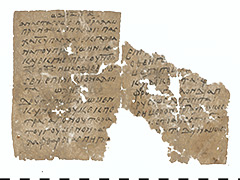BKT VI 6.3 (P. 9051)
„Resurrection Day“ – these words begin the first verse of the song on this writing and stand as the heading for what follows: Christ’s resurrection, the Easter.
Many hymns have been handed down from the Christian context. Certain festivals of the church year already had their liturgical songs even in the early days of Christianity. One such example has also been preserved here. This document is a double leaf of a codex, the predecessor of our present book. Of the four pages available for writing, three were inscribed with the Greek text of this hymn. Based on its form, the writing can be dated to the 10th century AD. The material used also points to this late period. It is paper.
The text contains excerpts from the Easter Canon of John of Damascus. The canon has survived well in other sources, so that one gets a fairly accurate picture of how much is missing from the paper sheet here. The canon consists of nine individual odes, which are identified and numbered here by headings. From this it is evident that incomplete remnants of odes 1 to 6 have survived on this paper sheet. It is conspicuous that ode 2 is missing. However, it is also missing from the rest of the tradition. It is assumed that it was omitted because of its excessive length. Compared to the complete text of the rest of the tradition, it is also noticeable that only the important first stanza of each ode has been included in the text on this double sheet. These first stanzas have a closer relationship to the biblical text. The two to three intermediate stanzas of each ode, which re-enact the biblical accounts, have been omitted. In all the odes of the Easter canon, the joy of Christ’s resurrection is sung, but thematised differently. The first ode focuses on the universal significance of the resurrection. The third ode is about the Eucharist, especially its life-giving power: Christ as the source of immortality. The fourth ode again ties in more closely with the first ode in terms of content when, at the end of its first stanza, the angel’s exclamation is quoted: „Today redemption is given to the world because Christ Almighty is risen.“ The fifth ode throws light on the liturgical celebration of the resurrection when, alluding to the biblical account, it is sung of the walk to the tomb, but accompanied by hymns rather than myrrh to anoint the corpse. The sixth ode thematises Christ’s descent to the dead and his victory over death.
The author of this Easter canon, John of Damascus, is a famous Christian theologian and church father. Not much is known about his life. Another problem is that many reports about his life are legendary. He is said to have died at the age of 104 on 4 December 749. He came from a wealthy Christian family from Damascus and spent the first part of his life in high state service under the Umayyads. He later left Damascus, perhaps due to the onset of Islamisation of the administration, and entered the monastery of Mar Saba southeast of Jerusalem as a monk, where he also died.
This Easter canon was thus created at a time when Damascus was already the capital of the caliphate and Islam was the dominant religion. The excerpts preserved here are about two centuries younger and come from Egypt, which was also Islamic.
These excerpts from the Easter Canon of John of Damascus were on display in the special exhibition „Soundscapes – Music in Ancient Egypt“.



